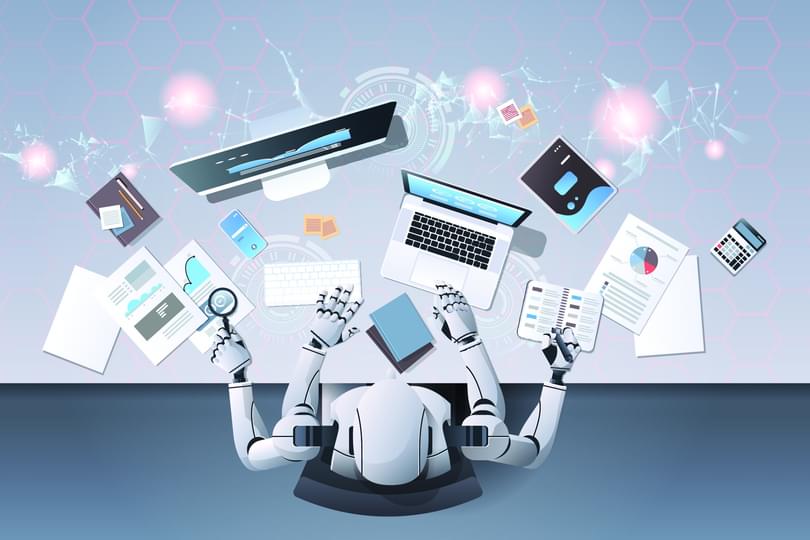
In June, thousands of dockworkers marched at the Port of Los Angeles against the coming introduction of robotic machines threatening their jobs. And they are not alone in fearing automation.
According to a recent Pew Research survey, a staggering 85% of Americans support policies to restrict the rise of robots. We even have a presidential candidate in Andrew Yang running to protect jobs from automation.
Economists tend to dismiss anti-technology sentiment as backwards and Luddite. But they miss an important point. As I argue in my new book, The Technology Trap, The Luddites, who smashed machinery during the Industrial Revolution, were right to fight back. Much like today's factory workers, they weren't going to benefit from new technology.
Parallels to the past can surely be taken too far, but unless we are careful, our current technological revolution in artificial intelligence and robotics may well turn out to be another tumultuous episode with dire social and political consequences.
The Industrial Revolution laid the foundations for the modern world we live in today. But getting there involved painful transition. Even as GDP per capita growth took off, the gains from growth didn't find its way into the pockets of ordinary people.
Between 1770 and 1840, average real wages were stagnant and even falling for those at the lower end of the income distribution, while output per worker grew by 46%. As craftsmen's incomes vanished and as their jobs were replaced by machines, poorer nutrition meant that people grew shorter by the generation. The gains of growth went to industrialists, who saw their rate of profit double. This famously led Fredrick Engels, who co-authored the Communist Manifesto together with Karl Marx, to conclude that the machine-owning industrialists grew "rich on the misery of the mass of wage earners."
Indeed, the Industrial Revolution began with the construction of the first factories and ended with the publication of the Communist Manifesto. Revolutionary technologies lead to political strife.
Why did working people agree to participate in the industrialization process if it reduced their utility? The simple answer is that they didn't. They petitioned to parliament to bring the installation of machines to a halt. And they rioted against the mechanized factory. While much popular commentary has focused on the Luddite uprisings of 1811-1816, they were only part of a long wave of machinery riots that swept across Britain, France, Germany and China, among other places.
Just like early spinning machines took the jobs of middle-income craftsmen, industrial robots have more recently diminished opportunities for the American middle class. The wages for men with no more than a high-school diploma, who would have flocked into factories before the rise of the robots, have steadily fallen since the 1980s. And, MIT economists Daron Acemoglu and Pascual Restrepo find that each industrial robot replaced about 3.3 jobs in the U.S. economy.
Jobs haven't disappeared evenly across the American economy. There are more robots in Michigan alone today than in the entire American west. Where the robots are is also where American's and their communities are hurting. Where jobs and incomes have disappeared, the opioid crisis is more prevalent, crime and suicide is on the rise, marriage rates are faltering, and unsurprisingly, people are more prone to vote for populist candidates.
My research with Thor Berger and Chinchih Chen of the Oxford Martin School shows that Donald Trump made the largest gains, relative to Mitt Romney's election result, in communities where robots were adopted most extensively. As during the Industrial Revolution, the losers to technology are demanding change.
Many automation technologies loom on the horizon. Nearly 3.5 million Americans work as cashiers, but if you shop at an AmazonGo store you won't see cashiers or checkout lanes. And autonomous cars could replace the jobs of millions of truck, bus and taxi drivers.
And we haven't seen anything yet. As artificial intelligence becomes more pervasive, so will automation and its effects. My research with Michael Osborne found that 47% of U.S. jobs could be automated due to recent advances in AI.
If history is any guidance, we could also see a similar backlash against automation. Hiking up tariffs is not going to bring manufacturing jobs back, which are already being automated away, even in China. What's more, the rise of China has already happened and most people in America today work in services that are delivered locally. In other words, most Americans are shielded from future globalization. But they aren't shielded from AmazonGo or autonomous cars.
The Luddite impulse may well return. And if the introduction of new technologies are blocked because some fear losing their jobs, long-term growth and economic prosperity will suffer as a consequence. The main difference between our current technological revolution and the Industrial Revolution is that the Luddites didn't have political rights. Today, in contrast, people don't have to vote with sticks and stones; they can simply show up on Election Day.
The long-term economic benefits of the Industrial Revolution were undisputable. But the industrialization process itself was a different matter. In similar fashion, the potential long-term benefits of AI are enormous. But harnessing them will require governments to implement policies to smooth the short-term disruptive consequences and avoid backlash.
This piece originally appeared on CNN Business Perspectives
This opinion piece reflects the views of the author, and does not necessarily reflect the position of the Oxford Martin School or the University of Oxford. Any errors or omissions are those of the author.
